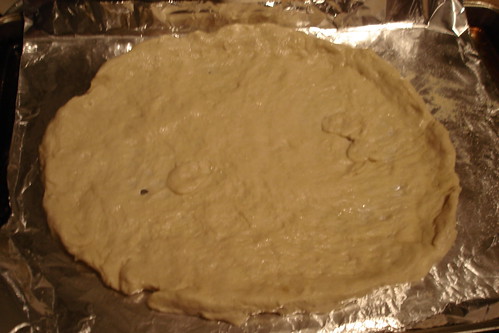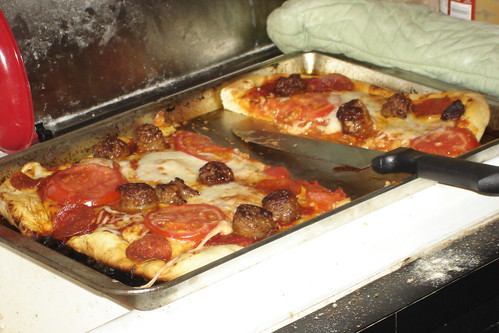As you know, I have no money. As you may or may not know, I love pizza. I probably love pizza more than I love you, no matter who you are. Random blog reader, friend, accomplice, undisclosed romantic interest- unless you happen to be a certain gentleman who has quite impressive skills in the paint- I am almost certain to have a deeper and more tender regard for pizza than I shall ever have for you.
No money plus great love for pizza = debt. Sadness. Tragedy. So, as I am wont to do when faced with tragedy, I went to my parents house. They did not make any donations to the cause. Then, I made my way to the traditional homeland of pizza: Rhode Island.
And in Rhode Island, I conducted a scientific study,of similar historic import to when that french fuck discovered oxygen by killing a pigeon, in order to answer the timeless question: How the fuck am I going to make good pizza without a pizza oven?

We've all experienced it. In order to save money, people will decide "Hey, it's just sauce, cheese, and bread. I can make that." And it never works. Why? Because pizza depends on heat sources unavailable to home cooks.
Problem- Fat melts at 100 degrees. Sugar burns at 400-ish. While water boils at 212, it takes time to get there, whereas your fat and your sugar go faster. In order for pizza crust to get chewy before it burns, the oven has to be hot enough that the water in the dough boils out before the sugars and fats start to incinerate.
Further problem: If your oven isn't hot enough to cook the dough fast, your dough will rise too much as it cooks. This creates the most loathsome situation known to man: Domino's Pizza. Doughy, bready, like an irish girl's low-rent approximation of focaccia...it's not pizza. It's bread with sauce, cheese added for modesty. No good. You simply can't bake a pizza longer to compensate for your tepid-ass, suzy-homemaker oven.

The solution is obvious: Raise the heat. Pizza stones were created for this; unfortunately, they're either expensive or shitty, or both. The stone you buy at the store is likely to be a rotten heat absorber and reflector. Alton Brown says to buy a marble tile at a home supply store, but as I mentioned, I have no money. So what's a girl to do?
Strategery, folks.
Strategy One:
My first strategy, one I've perfected in my dorm, is the old fall-back: Direct conduction. While the hottest setting on the dial of your stove may be 500 degrees, the temp. inside your oven varies. Gas only burns at one temp, after all. It's just that your stove is programed to turn the flame off and on, intensify it and temper it, until some part of the stove reaches the temp. on your oven dial. The hottest part of your oven is the floor, because it's closest to the flame. And the flame heats the bottom of the oven directly, instead of by heating the air around it, so it's even hotter.

So, in order to take advantage of the hot spot, make your pizza on your thinnest cookie sheet or cookie sheet substitute. Cover that sheet in tin foil, oil, and a dusting of either cornmeal or semolina flour.
At left, you can see our crust on the sheet, pre-toppings. After the pizza is constructed, into the oven at the hottest setting it has, for 9-12 minutes. (Results to follow at end.)
However, the direct conduction method has flaws. First, it's not translatable to electric ovens, for a variety of reasons. Second, it requires that the oven be turned up as high as it goes, which can be a problem; errant bits of oil on the cookie sheet, those that aren't covered by dough, may smoke and set off your fire alarm. Third, it makes people nervous to put things directly on the floor of the oven. They think it's unnatural, unsavory, perverse.
There's a second method that doesn't require putting the pizza directly on the floor of the oven; and, I'd hoped, would allow the pizza to be cooked at a lower temp. without sacrificing texture. Unscientifically, I'll call this "the less direct conduction method"; or the "I don't have a pizza stone method".
Cast iron is a fantastic conductor, store-er reflector, and distributor of heat. It's also durable, traditional, and non-stick. Really, cast iron pans are fantastic. They just require a little more responsibility than other pans. Or a significant other who is willing to do the maintenance.

So I took the cast iron skillet and put it in the oven, middle rack, upside down at 400 degrees, for 25 minutes, while I was assembling the pizzas. Then, I placed a pizza (on an improvised, reinforced tinfoil disk), on top of the skillet. This, I hoped, would allow the pizza to take advantage of the fantastic heat-transferring properties of cast iron, without resorting to deep-dish. In the purposes of science, I have to disclose that I made this pizza sauceless, because I was scared that if there was sauce that dripped, and the skillet was too hot to take out of the oven (and it was, for hours after), then we may have rust.
The third method was cast iron, not preheated. I took a little cast iron pan (a tortilla warmer- ten dollars at your local ethnic grocery), and tossed that onto the top rack. Let's call this the control grou
 p.
p.How'd they come out? Well, all three were edible. And all three were special in their own way, although they shared a common flaw: lack of cheese browning. As we all know, the ideal pizza has stretchy, gooey cheese, topped with an almost imperceptible layer of stiffer, crisper cheese. (This allows the pizza to be cut, without the cheese sliding off). All three of my methods focused on getting the crust cooked, not the cheese- so after the crust was done, I slid each pizza under the broiler for a few seconds.

Our tortilla-warmer pizza was beautiful, and only took a few minutes longer to cook than the other two pizzas. The crust was golden, the toppings were perfectly done, and it really did look like a delivery pizza. Check out the browning on
 the crust; the bottom was golden, and not a bit burnt.
the crust; the bottom was golden, and not a bit burnt.However, this pizza was, when cut, very doughy. Because the cast iron wasn't pre-heated, the dough got a lot of time to rise before coming up to temp. For illustrative purposes, check out this picture of an earlier, pepperoni pizza, made with that method. Take a close look at how thick the crust, how midwestern the profile. It was edible, tasty, even. Better than gourmet frozen, better than Pizza Hut; but not better than your finer House-Of-Pizzas.
Our other cast-iron pizza had a less pleasant appearance. This may b
 e because it was the only pizza not to spend any time below the cast iron pan, so the crust didn't get as nice and brown from reflected heat. However, the crust was chewy, flexible, foldable. The cheese was nicely melty, and the short cooking time and moderate heat left vegetable toppings cooked, but not mushy. The ideal, I think, would be to bake a pizza both on top of, and immediately below, pre-heated cast iron pans- that way, the crust is golden brown and crisp on top, tender and chewy on the bottom.
e because it was the only pizza not to spend any time below the cast iron pan, so the crust didn't get as nice and brown from reflected heat. However, the crust was chewy, flexible, foldable. The cheese was nicely melty, and the short cooking time and moderate heat left vegetable toppings cooked, but not mushy. The ideal, I think, would be to bake a pizza both on top of, and immediately below, pre-heated cast iron pans- that way, the crust is golden brown and crisp on top, tender and chewy on the bottom.This pizza crust did not have the traditional Dominos/Pizza Hut/Boboli thickness. It was thin enough that, if the pan had been large enough, one could pass it off as delivery.
Finally, we come to th
 e old favorite, my standby direct conduction pie. This pie was tasty. The crust was a little too thin in places- it was hard to keep the toppings on; however, that may have been due more to the large size of the pizza than the method of cooking. It was delicious otherwise, with fine browning, and the cookie sheet made it easy to take out of the oven and put under the broiler to crisp the cheese.
e old favorite, my standby direct conduction pie. This pie was tasty. The crust was a little too thin in places- it was hard to keep the toppings on; however, that may have been due more to the large size of the pizza than the method of cooking. It was delicious otherwise, with fine browning, and the cookie sheet made it easy to take out of the oven and put under the broiler to crisp the cheese.This method works better with fatty, lightweight
 toppings, than with high-water, high-weight vegetable toppings. While it was difficult to keep hold of our peppers, onions, and mushrooms, an earlier pizza made using this method was able to handle garlic sausages, fresh mozz, and pepperoni quite nicely, as seen at right.
toppings, than with high-water, high-weight vegetable toppings. While it was difficult to keep hold of our peppers, onions, and mushrooms, an earlier pizza made using this method was able to handle garlic sausages, fresh mozz, and pepperoni quite nicely, as seen at right.Conclusion: If you want a big pizza, and you have a gas oven- just fearlessly, boldly, bravely, put it on the floor of your oven. Remember that pepperoni always helps, and that turning the dial as far as it goes feels so good. If you don't have a gas oven, but you do have a cast iron skillet, try that. Better yet, use two, and preheat them both. Finally, if you haven't got the foresight to preheat your skillet, but somehow have come into possession of pizza dough, cold cast iron works almost as well, as long as you're willing to accept a little more dough in your life.

2 comments:
What do you have against pan pizza? It's so delicious.....
Rob, remind me again what region you hail from?
Post a Comment